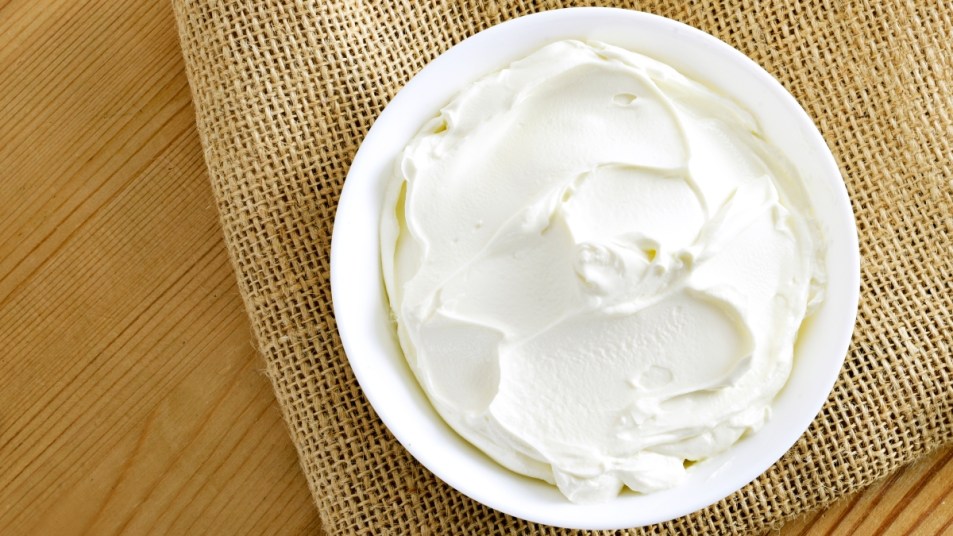3 Reasons To Try Quark, the German Cheese-meets-Yogurt That’s Good for Your Gut
It's versatile and delicious.

If the word “quark” sparks memories of physics class, rest easy: a) I’m not qualified to write about physics; and b) that’s not the kind of quark we’re talking about. This quark is a cheesy, yogurt-y treat that’s becoming more and more popular, and for good reason. It’s delicious and packed with nutritional value. Learn more about quark and how it could (and should) become your new favorite nibble.
What is quark?
Quark is a soft, smooth European cheese that Germans eat with gusto. It has a mild flavor, and is reported to taste a little bit like sour cream and cream cheese. Others claim that with its flavor and texture, quark resembles a mix between yogurt and cottage cheese. Gut-healthy food website Cultures for Health says it is “made by fermenting a mixture of cheese and yogurt cultures in warm milk to form curds. After that, the whey (liquid) is squeezed out.”
How do you eat quark?
As a soft cheese with the pudding-like texture of yogurt, quark can be eaten several ways. In terms of flavor, it’s not as tart or tangy as Greek yogurt. This mildness makes it versatile — it can go sweet or savory. “In northern Europe, it’s common to spread quark on toast in the morning, like you would butter,” chef Peter Sandroni tells Prevention. He adds that you can use it in recipes that call for soft, creamy cheese like ricotta. Conversely, it can be mixed with fruit or enjoyed on its own as a quick, healthy breakfast. The only limit to how you eat quark is your imagination..
Where did quark come from?
There are numerous theories about quark’s origins. Many food writers and historians believe it was invented in the 1920s; some, however, believe it was invented earlier, but didn’t become popular until the 1920s. Several sources claim quark dates back to 14th century Europe; while still others say it’s much older, and point to the Roman historian Tacitus, who wrote about it in 98 A.D., as evidence. Because quark bears similarity to the unaged, white cheeses found in other cultures, like paneer and queso blanco, it’s difficult to trace its exact roots. Whatever its origin, it is well-loved: it even has its own global celebration each year. January 19th is World Quark Day, as established by a mysterious enthusiast who goes by The Queen of Quark. She also published The Ultimate Quark Guide & Cookbook (Buy from Amazon, $14.49).
What are the health benefits of quark?
Now that you know what it is and how to eat it, the question is: Why should you eat it? Aside from being creamy and delicious, quark has tons of benefits for your body. Learn more about what makes this quirky (quark-y?) cheese worth its nutritional weight in gold.
It’s gut-friendly (in more ways than one!): Like Greek yogurt, quark is filled with gut-friendly live cultures and probiotics. Probiotics help regulate the healthy bacteria in your gut, aiding in digestion and strengthening immunity. Its live cultures aren’t its only tummy-friendly quality: It’s also lower in lactic acid than Greek yogurt and is rated as a low FODMAP food, meaning that it’s easier for people with stomach issues and lactose intolerance to enjoy.
It’s packed with protein: If you’re looking to build muscle, or to simply eat something that will keep you full for a while, look no further. Quark is filled with protein — almost double the amount of protein found in Greek yogurt, according to Graham’s Family Dairy.
It’s low in salt and fat: Quark is a great substitute for some otherwise fatty, salty cheeses. Graham’s Family Dairy notes that “quark can in some cases contain up to 40% fat, [but] is naturally fat-free,” so if you shop wisely, it can be a snack that helps to keep your cholesterol in check. It’s also lower in salt content than similar softies like cottage cheese and ricotta, making it a healthy substitute if you’re watching your sodium intake.
It’s full of essential vitamins: This delicious and versatile treat is chock-a-block with crucial vitamins. It contains vitamin A, which supports healthy vision and the immune system, and vitamin B12, which maintains the nervous system. Additionally, full-fat quark is high in calcium vitamin K, which is important for heart health, bone health, and blood clotting.
The only bad thing about quark is that it’s not as widely available in the US as its better-known peers. Well + Good notes that it can be found at some grocery chains like Kroger, Sam’s Club, and Costco. If you’re not having any luck finding it, you could try making it yourself.













